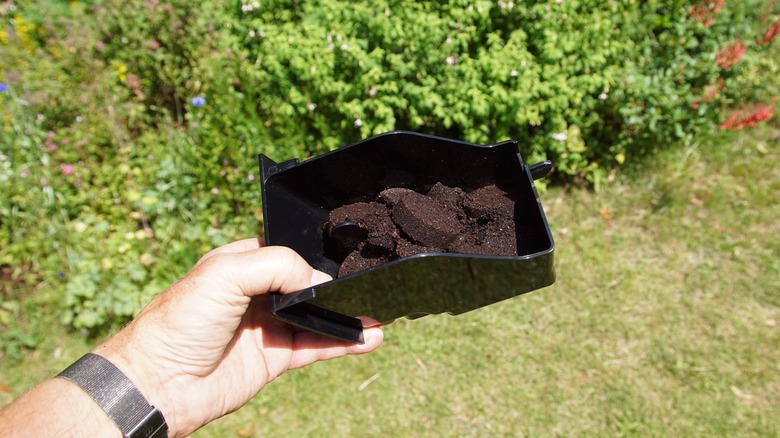Why Do People Add Coffee Grounds When Growing Rhododendrons & Should You Try It?
The exultant promise of scintillating hummingbirds doting on just-as-gorgeous pink flowers might've cajoled you into planting a rhododendron bush like azaleas — sans a soil test. But you may not have been forewarned about what spring could herald in instead: yellowing foliage, and not the highly anticipated funnel blooms (and plumage). Preferring their soil's pH levels to hover between 4.5 and 6.0, rhododendrons will stall their growth due to a lack of iron when they're grown anywhere that isn't amply acidic. However, since pre-planting amendments aren't an option anymore, and saving the damaged plant is necessary, many gardeners resort to conditioning the soil with cast-off coffee grounds. However, due to the lack of acidity in spent coffee grounds, that might not actually work.
A frequent fixture in the compost pile and the pest-repellent armory, many people use spent coffee grounds for soil acidification. As anyone who's had one too many coffees in a day can vouch, these caffeine brews are, indeed, potently acidic. So, the rational flows that working the used-up grounds into the soil might lower its pH levels, benefiting acid-craving plants, such as rhododendrons. Unfortunately for most gardeners, this homely hack story isn't as simple as separating grounds from the filter, and requires spilling some beans.
Coffee grounds aren't your beany ticket to acidic soils
Although it's incontestable that coffee drinks are acidic, their spent beans? Not so much. They veer closer to neutrality, and their pH levels vary from 6.5 to 6.8. Moreover, after the coffee grounds begin decomposing — which they will once the soil microbes get working — they're unlikely to provide an acidic boost, with variable results at best. Dr. Linda Chalker-Scott demonstrated in her write-up for Master Gardener that acidity levels dipped to 4.6 in one experiment, while rising to 8.4 in another after composting the coffee grounds. She found studies where the drop in pH levels from discarded coffee residue was short-lived, highly punctuated in the initial phase — but neutralizing after 21 days.
While java roast has many potential benefits in the garden, raising soil acidity levels isn't it. Instead, when your rhododendrons are languishing in unfavorable soils, an inexpensive and fool-hardy way to improve their condition and lower the pH level around them is to amend the soil with elemental sulfur. But if you want quicker results, aluminum sulfate may be the path to tread, but it's not as economical. Whichever option you choose, follow the directions on the soil amendment to use around your rhododendron or azalea bushes.
Coffee grounds improve the soil profile
While the percolating truth about the coffee-acidity relationship might not exactly hearten natural enthusiasts, there are other reasons to rejoice. For starters, composted coffee grounds can release around 2% nitrogen into the soil, and work as a suitable alternative for nitrogen-rich manures. Obviously, first you should explore the easy ways to tell if your garden soil is lacking in nitrogen. Or, you could start with a soil test before your rhododendron grows foliage-heavy from all that nitrogen offloading, which will ultimately deprive you of the hummingbird-dotted blooms.
That's not all. Coffee grounds also break down into trace quantities of potassium, magnesium, phosphorus, copper, and calcium, enriching the soil. Though a lot of credit goes to earthworms who rise to the occasion and drag the disposed-of grounds to deeper layers, thereby improving the soil structure, texture, and water retention capacity. However, be sure your soil is actually nutrient-deficient before dishing out the coffee magic so that you don't overcompensate and ruin your dirt.
Also, avoid the rookie mistake when using coffee grounds in the garden as mulch: never spread them thicker than a ½ inch. Otherwise, they'll compact the soil, blocking air and water movement. Instead, top them up with wood chips (preferably 4 inches high) for the healthiest soils. Finally, don't apply coffee grounds if you're starting your plants with seeds, unless you wish to slow down (or worse, shut down) the already snail-paced process.


